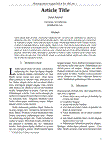Aspectos nutricionales del pescado blanco de Pátzcuaro (Chirostoma estor estor Jordan, 1879)
The silver side from Patzcuaro lake in central Mexico is an species with a great regional importance. Its prices areimpressive high in the local markets. Unfortunately the high fisheries pressure and the pollution of their environmenthave become the species in danger. A lot of effort has been done t...
| Autores principales: | , , , , , , , |
|---|---|
| Formato: | Artículo |
| Lenguaje: | inglés español |
| Publicado: |
Facultad de Ciencias Biologicas
2019
|
| Acceso en línea: | https://nutricionacuicola.uanl.mx/index.php/acu/article/view/182 |
| Sumario: | The silver side from Patzcuaro lake in central Mexico is an species with a great regional importance. Its prices areimpressive high in the local markets. Unfortunately the high fisheries pressure and the pollution of their environmenthave become the species in danger. A lot of effort has been done to develop their pilot culture. The present paperdescribes the advances in feeding and nutrition of those important fish. The studies of the feeding anatomy of thespecies permitted classify it as a carnivorous zooplantofagous fish, that occasionally feed small fishes andcrustaceans when adult. Studies on the enzymatic activities in a stomach less intestinal tract, with a high pH, showthat chemiotrypsin is the most important enzyme; the activity for this enzyme for the day 20Th after hatching ( higherof 15,000 mU/mg) overtakes the values for the same enzyme activities (900mU/mg) for Morone saxatilis, acarnivorous fish with stomach. Studies to determine the protein requirements for Chirostoma estor estor shown 42%protein requirement in the diet with the best survival and best growth. Other studies to determine the vitamin Crequirements shown that juveniles have a requiremet of 93.2mg vitamin C / Kg of feed. In terms of fatty acidrequirements, the species shown a high capacity to convert EPA or other omega 3 fatty acids to DHA. The highlevels of DHA and EPA in the flesh makes this fish a very important species for human nutrition unless it is a freshwater species. |
|---|---|
| Descripción Física: | Avances en Nutrición Acuicola; 2006: Memorías del Octavo Simposium Internacional de Nutrición Acuícola |
